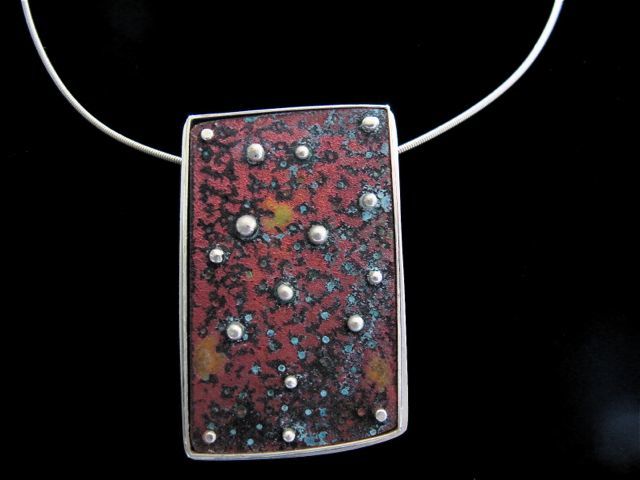Materials: copper, sterling silver, fine silver
Dimensions: 1.25" x 2"
Chased and heat colored copper with fused fine silver balls is set in sterling. The back of the setting is pierced to reveal green acrylic inside the setting.
Photo credit: Suzanne Krill
Suzanne Krill
Raleigh, NC. USA
Having come to jewelry from a printmaking and ceramics background. I found that surface treatments used in these art forms translate to the jewelry world. I am not really a production jeweler, preferring instead to explore ideas, that while building on one another, result in one of a kind pieces.
I am totally captivated by the seemingly endless possibilities offered by nature for the creation of my jewelry. I maintain a garden at my home and use the macro option on my camera to photograph 'flora and fauna' found there. The shapes, patterns and textures fuel my creative process. A recent 'shape muse' reflected in my work is a 'cauliflower' mushroom that grew twice in my garden during severe drought. Its undulating crevices and positive and negative areas offer an abundance of design possibilities. I am also interested in life at the cellular level, the unseen structures of life, rich with patterns and textures visible only through extreme magnification.
Materials, technique and color also stimulate my creative process. Printmaking plays an underlying role in much of my work.I have been exploring an enameling technique that is reminiscent of inking an etching plate. Colored plexiglas combined with silver adds another dimension to my jewelry; it can be handled a bit like metal minus the heat and hammers. Heating metal is another exciting source of unexpected color and surface.
One never knows from where the next creative jolt will come - but it will come. It may exist in isolation for a time, then be combined with another element or two, and then be recombined with other ideas, materials and processes. A rich tapestry results - evidence of the creative process at work.
This is how things work for me. Even though I feel that I have not fully explored my current ideas, I always wonder what is around the next corner waiting to influence my work.
The exhibition explores metal works whose primary theme is color embraced as their primary visual focus, whether that be using colored materials, exploring creating colored surfaces, or encasing the object in color.
As the world's largest jewelry related internet site, Ganoksin strives to develop exhibitions showcasing work from around the world. This exhibition was open to all metalsmiths, professional and amateur, advanced and beginner.
In total 303 artists contributed 814 show pieces for the permanent online exhibition.
The exhibition was curated by Beth Wicker, President of the North Carolina Society of Goldsmiths in the United States, and Adjunct Instructor at Northeastern Technical College in South Carolina. Director of the exhibition is Hanuman Aspler, founder of The Ganoksin Project, the world's largest internet jewelry site.
Hue is one of the primary properties of color, it refers to the place the color occupies on the visual spectrum. Humans have used hues throughout time, to create cave paintings, to decorate themselves, their clothing and their housing.
Different hues have taken on different meanings throughout time. Gold traditionally has been a color of purity - the metal gold is relatively unchangeable, and the hue of gold has come to stand for gods and goddesses, for royalty, for durability and for purity. Red has often meant love, or passion. Hues often reflect the meaning of the seasons, with pastels referring to spring and the burst of new life after the pale hues of winter. Summer is reflected in vibrant, deep hues, followed by the browning of hues in the fall as plants go to seed and die, and the land turns fallow.
The worth of a hue has often been tied to what is necessary to make the pigment that creates the hue, and the expensive involved in the process. Often created from crushed stones that had to be mined and carried by caravan over thousands of miles, or from fermented roots of plants only grown in certain areas, or the carapaces of rare insects - the creation of hue in a way that could be used by man was an involved and generally expensive process.
In today's world metalsmiths have access to perhaps the widest range of materials and hues in the history of man - and in some of the most affordable ways ever.
This exhibition celebrates hue - color - as an integral, inherent element of the work. We talk of the "richness" of color, and examples of this abound here. One expects hues from the colors of gemstones used in metalsmithing, but we also have hues from some less expected places. Glass enamels are an ancient way of adding color, as are a variety of patinas. Today's artists also use synthetic man-made materials to add color in ways that didn't exist a century ago.
We invite you to enjoy this celebration of hue, and the ways hues and their use have changed over time.
